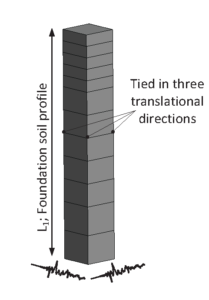The Tcl files below perform site response analysis for level ground condition by applying ground motion to a stack of three-dimensional nonlinear soil elements (see Figure 1). I have uploaded two separate codes for dry soil and saturated soil conditions. The code for latter is capable of simulating liquefaction. Please also read the article about base boundary condition. The feature for switching into either rigid base or compliant base boundary conditions is available in the code.
 Figure 1. Stack of three-dimensional soil elements under seismic loading
Figure 1. Stack of three-dimensional soil elements under seismic loading
developed by the TCL file.
To download Tcl file for dry soil condition, click here: siteResponseAnalysis_Dry.zip
To download Tcl file for saturated soil condition, click here: siteResponseAnalysis_Saturated.zip
Please review the “Notes” carefully before using the tcl files. The validity of the code can be checked by reviewing Chapter 6 of my PhD thesis available here.
3 thoughts on “Fully nonlinear elastoplastic site response analysis – TCL file”
It is possible with this Tcl code to create a continuous, large-scale, three-dimensional model as a finite element mesh that allows for a better performance of site effects.
Cheers regards.
Hi Frank,
This tcl code just create a single stack of soil elements (8-node brick elements). Not sure what site effects you are referring to. It is well-established that this model can sufficiently capture all mechanisms involved in seismic site response.
Hope the above answers your question.
Hi Amin,
I wondered if ma use several stacks of three-dimensional elements of the ground by way of continuous finite element model.
CHEERS.